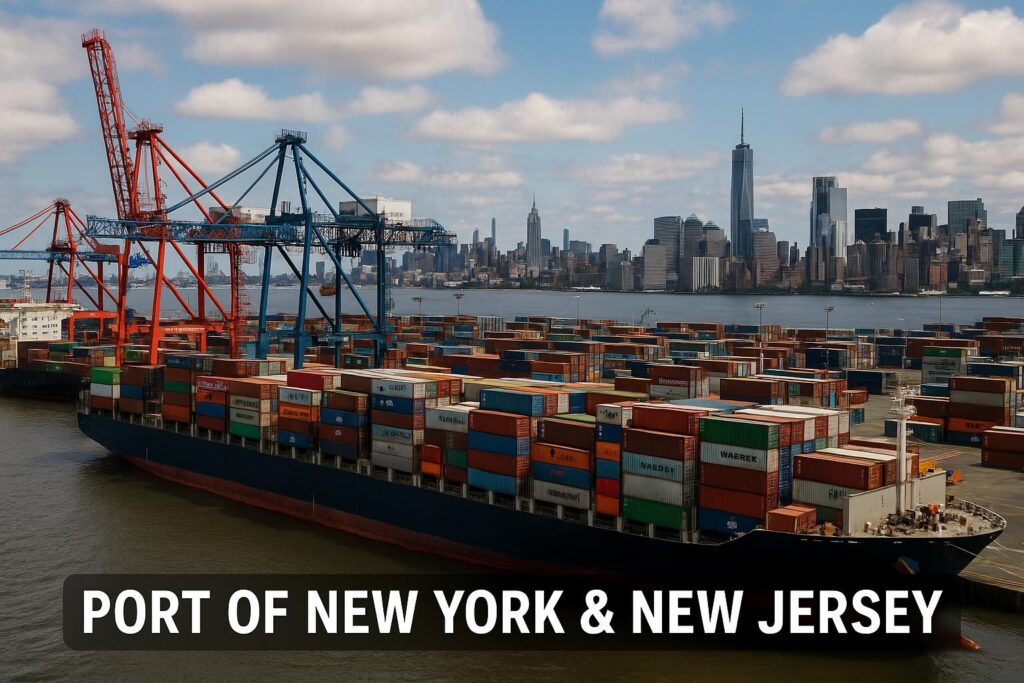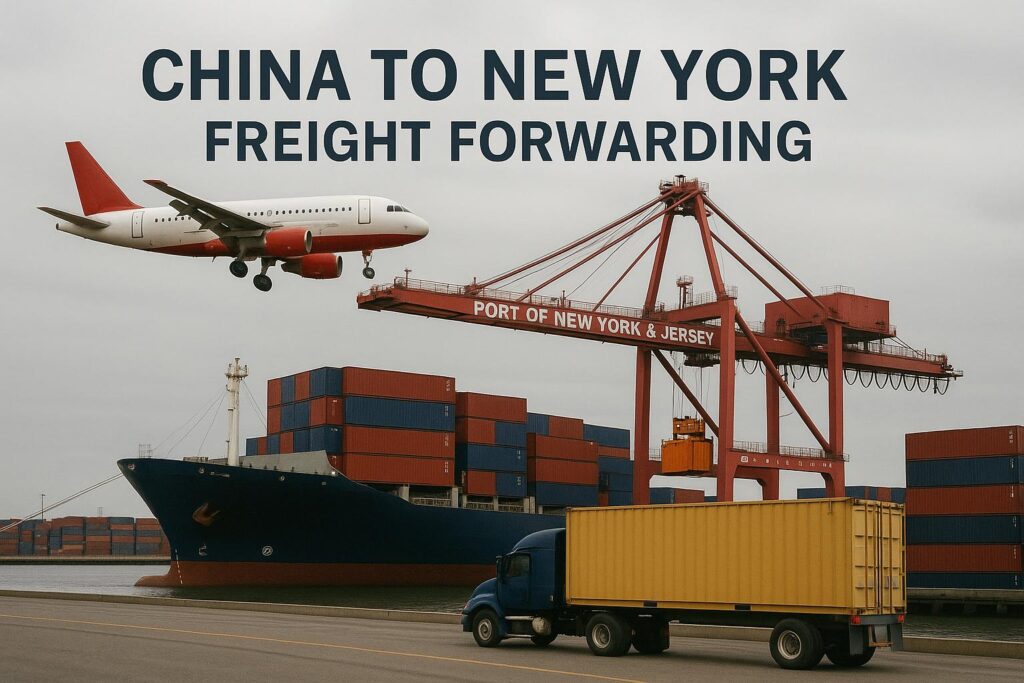Introduction – A Vital Gateway for Global Trade
The Port of New York & New Jersey is recognized as the busiest and largest seaport on the U.S. East Coast, playing a central role as a key shipping hub for international trade and global supply chains. Managed by the Port Authority, the port serves as a critical entry point for goods moving between North America and major global markets, supporting both imports and exports.
Located in the Upper New York Bay and the New York Harbor, this fully mobilized port facility connects to major inland markets through advanced road, rail, and maritime networks. It is not just a container port, but also a key economic driver for the region—creating good-paying union jobs, encouraging women-owned businesses, and contributing to the local economy.

Port Authority’s Commitment to Infrastructure Improvements
The Port Authority Board has consistently demonstrated its commitment to keeping the Port of New York & New Jersey at the forefront of global trade. Through significant infrastructure upgrades and major private investment, the port has expanded its terminal facilities, upgraded cargo handling equipment, and implemented new systems to improve efficiency.
Recent projects include expanding excess container storage areas, deploying zero emissions equipment to reduce environmental impact, and introducing advanced digital tracking for faster cargo clearance. These infrastructure improvements not only enhance the port’s capacity but also help mitigate global supply chain issues. By doing so, the Port Authority’s commitment ensures the port remains one of the major distribution hubs in the nation and a reliable link for international trade.
Staten Island’s Strategic Role in Economic Growth
The Staten Island Terminal, officially known as the Howland Hook Marine Terminal, is one of the borough’s vital economic engines. It plays a crucial role in boosting Staten Island’s economy by handling a significant share of the region’s container port activity. As part of the Port of New York & New Jersey, the terminal connects directly to major inland markets, making it a key economic generator for both the borough and the state.
Through continuous expansion and major capacity boosts, the terminal has created good-paying union jobs, supported Staten Island commerce, and offered new opportunities for women-owned businesses. These developments are not only benefitting Staten Island residents but also growing Staten Island’s economy in ways that strengthen the local economy and ensure a sustainable economic future for the community.
Container Terminals and Port Jersey Operations
The Port of New York includes multiple high-capacity container terminals strategically located in Newark, Elizabeth, Staten Island, and the Port Jersey area. These terminal facilities are equipped with advanced cargo handling equipment, automated gate systems, and modern logistics services to ensure efficient operations.
The Port Jersey complex serves as a major distribution hub on the East Coast, providing direct access to highways, rail lines, and the York New Jersey port system. As a shipping facility, it has undergone significant infrastructure upgrades to increase throughput, reduce congestion, and enhance safety. With excess container storage capabilities and advanced scheduling systems, Port Jersey plays a key role in maintaining the port’s capacity and ensuring smooth cargo movement for importers and exporters.
Rich Maritime History and Modern Shipping Facility
Situated in the Upper New York Bay and the heart of the New York Harbor, the Port of New York & New Jersey has a rich maritime history dating back centuries. Originally a trading post, it has evolved into a critical entry point for international commerce and one of the busiest hubs in the global supply chain.
Today, this fully mobilized port facility combines historical significance with modern innovation. State-of-the-art shipping facilities handle millions of containers annually, supported by advanced scheduling systems, upgraded berths, and integrated logistics services. These enhancements allow the port to operate efficiently even during global supply chain issues, maintaining its status as one of the most reliable and strategically important container ports in the world.
Explore more shipping guides:
Top 7 Busiest Seaports in the United States
Port of Long Beach: Shipping Guide
Top East Coast Ports in the USA (2025 Guide)
Key Ports for Logistics from China to the USA
Sea Freight Shipping from China to the USA: A Complete Guide
The Suez Canal Shipping Guide (2025)

Economic Impact and Local Benefits
The Port of New York & New Jersey is a key economic driver for the region, generating billions in revenue and fueling both economic development and economic growth. By connecting global markets to U.S. consumers, it strengthens the local economy while supporting the broader national supply chain.
Thousands of good-paying jobs—including good-paying union jobs—are tied to port operations, from dockworkers and truck drivers to warehouse staff and customs specialists. The port also actively supports women-owned businesses, awarding contracts that help diversify and expand the business community.
These benefits extend far beyond shipping. As one of the borough’s vital economic engines, the port plays a central role in Staten Island’s economy, ensuring opportunities for residents and fostering partnerships that drive long-term economic future stability.
Port’s Capacity and Major Distribution Hubs
With years of targeted investment, the port’s capacity has reached record-breaking levels, allowing the Port of New York & New Jersey to handle a greater volume of cargo than ever before. As one of the nation’s major distribution hubs, it supports the seamless flow of goods from the docks to major inland markets across the Midwest and beyond.
Operational efficiency is ensured through strong labor partnerships, including the International Longshoremen’s Association Union, whose members are essential in loading, unloading, and moving goods through the port’s terminal facilities. In recent years, the port has assumed operational control of critical areas to further streamline processes and improve coordination.
This combination of enhanced infrastructure and skilled labor ensures that the port remains one of the most reliable container ports on the East Coast, capable of meeting demand even during peak shipping seasons.
Commitment to Sustainability and Renewable Energy
The Port Authority’s commitment to promoting renewable energy is shaping the future of the Port of New York & New Jersey. As part of its long-term strategy, the port has invested in zero emissions equipment, shore power connections for vessels, and cleaner fueling options for trucks and cargo handling machinery.
These sustainability initiatives go hand in hand with significant infrastructure upgrades, ensuring that environmental responsibility is integrated into every stage of port operations. By reducing greenhouse gas emissions and improving air quality, the port not only addresses climate challenges but also strengthens its role as a forward-looking leader in international trade.
Through these efforts, the York New Jersey port is setting a new standard for environmentally conscious shipping facilities, proving that economic growth and environmental stewardship can work together.
Conclusion – The Future of the Port of New York & New Jersey
Looking ahead, the Port of New York & New Jersey will continue to serve as a key shipping hub and critical entry point for goods entering the United States. With ongoing infrastructure improvements, expanded port capacity, and advanced logistics services, it is well-positioned to remain a leader on the East Coast and in global trade.
From the Howland Hook Marine Terminal on Staten Island to the busy Port Jersey complex, every part of the York and New Jersey port network plays a vital role in driving economic growth, creating good-paying jobs, and supporting women-owned businesses. The Port Authority’s commitment to innovation, sustainability, and efficiency ensures that the port will continue to meet the needs of shippers, consumers, and the local economy for decades to come.
As one of the nation’s busiest and largest seaports, the Port of New York & New Jersey is more than just a transportation hub—it is a key economic generator and an enduring link in the global supply chain.

